Words by Johanna Harlow
If you’ve ever watched motorsports, you may have pictured yourself behind the wheel of a sleek, sexy stock car, effortlessly cruising the track’s turns. Not so fast. It might look like a breeze, but NASCAR racing drivers like 19-year-old Jesse Love know better.
“Nothing’s more physically exerting than running a full race on a really hot day,” the Menlo Park native acknowledges. “It’s hell on your body.” These speed machines can match the G-force that astronauts experience during liftoff. And then there’s the heat factor. The temperature in a car can easily soar to 120 degrees Fahrenheit—170 degrees by the floorboards. Drivers commonly lose 5 to 10 pounds in sweat during a race. Now imagine trying to make split-second decisions at 200 MPH, over several hours. It’s why Jesse starts each day with heat tolerance training, welcoming the morning at 5AM with cardio and weights in a sweltering 120-degree room.
While other kids played with Hot Wheels and Matchbox toy cars, Jesse took the driver’s seat early. As a kindergartner, he recalls hanging out at a Mountain View race shop with his Uncle Tony, whose two daughters raced in quarter midgets (think go-karts but with four-wheel suspension). “Then I got into Antonia’s purple quarter midget,” Jesse recalls. That was all it took. After winning his very first quarter midgets race at the wee age of five, Jesse continued competing—racking up countless wins, including multiple state and national titles, all before he reached age 10.

Then Jesse started strapping into stock cars. Full-throttle ahead, he moved to North Carolina at 15 to further his career, that same year dominating in the ARCA Menards Series and becoming the youngest driver to win a title. He now competes full-time in the NASCAR Xfinity Series and drives the No. 2 Whelen Chevrolet for Richard Childress Racing.
Though racing may be physically taxing, Jesse estimates it’s only 30% of the battle. “There’s a lot of pressure involved,” he shares, mentioning that one of his mental coaches, Akshay Nanavati, is a Marine veteran—and the first polar explorer to undergo a solo sea-to-sea ski crossing of Antarctica with no sled or dogs.
Jesse must be bold on the track, taking calculated risks, managing stressors and reacting to the unexpected. He must dart into narrow gaps with the kiss of a bumper—because even a moment’s hesitation will close that window of opportunity. He must also make peace with crashing, which in motorsports isn’t an “if,” but a “when.” “I’ve flipped probably a dozen times,” estimates Jesse, adding with a note of neutrality, “The flips don’t always hurt the worst because stuff’s flying off your car, and you’re dispersing energy.” Hitting dead on the wall is more brutal on your body—even with the car’s head-and-neck restraints. “I wreck a lot less now than I did then when I was trying not to wreck,” he reflects. “You just kind of get in a zone.” And when the inevitable happens? “You just hop on out and live to race another day.”

A strong Christian, Jesse credits a faith-driven frame of mind for keeping him grounded in the wake of national recognition. “I’m racing for someone bigger than me,” he shares. “Being connected with God and treating people the same, whether they’re from Park Avenue or a park bench.”
He also cites his father as a strong influence. Jesshill “Duke” Love drove in quarter midgets himself in his youth, competing alongside his racing pal Jeff Gordon. Though he later pursued a career in law in Redwood City rather than continuing down the racetrack, Duke shaped his son’s integrity and driving style. “You change a lot,” Jesse reflects of his racing approach, “but your core values of how you’re going to race, how you’re going to let people race you, what your driving style is, what kind of car (tight, loose, however that is)… how I like to drive now was ingrained in me when I was raised by my dad.” He follows up, adding, “The most important advice that my dad gives me has nothing to do with racing at all. It’s all about life.”
Whenever he can, Jesse tries to spend time at the shop where mechanics disassemble, replace, install and adjust every part of his car. “I’m a big believer in being available and showing people that I care,” he says. “I want my guys at the shop to know that I’m gonna work really hard for them. And when that happens, they’re gonna work harder for me as well.” It takes a village to raise up a racing driver and Jesse’s crew chief, car chief, shock, engine and tire specialists, engineers, shop team and pit crew keep him on track.

With a racing nickname like The Hammer, it’s unsurprising that Jesse takes such a dogged approach to growth. “There’s a million things that you can do to just move the needle 1% forward,” he says. If that means poring over data, working with the simulator, attending countless pre-race meetings or watching 16 hours of film from Daytona until his eyes fatigue, so be it. “Even if you look at five hours of data and you find one thing that can help you go faster, we would all give our right thumb to find a tenth of a second,” Jesse states.
“I’ve qualified by a thousandth of a second—and I’ve been beaten by a thousandth of a second.” The young driver’s gaze drifts as his thoughts turn to the road. In his mind’s eye, he’s already hugging the turns and zipping down the straightaways of his next race. “I try not to focus on what any other driver does,” he shares. “I try to just focus on what I did today and what I can do tomorrow that was better than today.”


